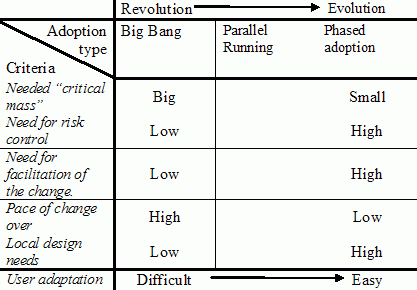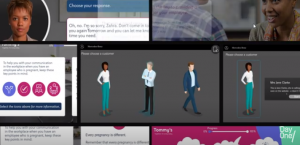A good software adoption plan that involves a clear user engagement and onboarding strategy is key to your project’s success. Half of IT projects fail, and not due to poor tech, but because of poor communication.

Here we look at how to create a software user adoption strategy that makes communication a fundamental part of your business plan, process and implementation.
“The Biggest Barrier to Enterprise Application Success:
User Adoption”
Oracle
Many IT teams believe that if they choose the best software product or create innovative systems for their company, then the relevant staff just need to follow the user guides to get to grips with it, and all will work out fine.
This couldn’t be further from the truth – the sourcing of great software and systems is just the start of the process and ensuring user adoption, engagement and effective training is often the key ingredient that will dictate project success or failure. A user centric approach is more important than the search for the best software product.
Here we look at 3 overarching user adoption strategies to consider, and potential pitfalls to avoid.
User Adoption Strategies – Revolution or Evolution?
When employees feel very busy (which is pretty much all the time in most organisations), it’s common for there to be some resistance when it comes to the introduction of new systems.
There is always a learning curve when it comes to new system adaptation, so any potential business risks from human error during the early stages of its use must be estimated and managed during this phase.
The new system will presumably bring business benefits in the way of cost-saving or productivity gains, at least in the long term. Therefore, managers will usually want to realise these benefits as quickly as possible, while balancing this with the risks.
Eason illustrated 3 user adoption strategies for new IT systems way back in 1988, using this graphic that’s still relevant today:

‘Big Bang’ Software Adoption Plan
If speed is required in new system implementation then the Big Bang software adoption plan approach provides Revolution on the graph above.
The upside of this approach is that the cost-saving and / or productivity benefits of a new system can be realised very quickly.
It comes with the most risk, as with the Big Bang the old system is no longer available as a backup if users get stuck. Therefore, excellent project planning, communication and management are required to ensure that errors are estimated and minimised.
It’s reported that project management issues cause more than 50% of IT project failures, compared to only 3% being caused by deficiencies in technical aspects of the new system.
If a new system implementation has a high level of potential impact – both positive and negative – then you’ll want to ensure that you have skilled and experienced project managers in-house or available to be brought in to manage the process.
Ideally, you’ll enable your teams to practise use of the new system in advance of its go-live, using a sandbox environment or system simulation. This will help to reduce errors and maximise productivity on day one with the new system.
Parallel Running Strategy
Running the old and new systems in parallel while staff gain proficiency is a risk-averse adoption strategy, and often seems like a sensible approach.
Even if users actively use the new system from the outset, the old one is there during the transition phase as a security blanket.
However, unless there is immediate positive impact on their work in terms of time-saving or productivity, staff will often gravitate towards maintaining the status quo.
With this approach, users may need additional encouragement to get on board the new system, and communication about the benefits for the individual users, as well as the organisation as a whole, will become even more important.
In an online poll conducted by CompTIA (the Computing Technology Industry Association), 28% of the 1,000 respondents said that poor communication was the #1 reason for IT project failures.
Communication before and during the staff onboarding phase is essential to prevent inertia killing off the parallel running approach.
Phased Adoption
This is another type of Evolution, where aspects of the new system are introduced incrementally – almost like a series of ‘mini big bangs’. This prevents the risk of complete inertia that can result from parallel running, as users are forced to adopt aspects of the new system over a pre-set schedule.
Phased adoption can be less daunting for users and can leverage the benefits of bite-size learning. However, it also lacks the speed benefits of the Big Bang approach, so will not suit all projects.
Even though the change is incremental, users should be given training in the new modules of the system in advance, so that the adoption of them at each stage is as smooth as possible.
User Adoption Plan & Checklist
To ensure successful staff onboarding for new software and systems, you’ll want to create a user adoption plan that takes into account both the project goals and the people and culture of your organisation.
A 10-point checklist of key considerations for your software adoption plan should include:
- New system rationale and overall project goals
- Required or ideal timescales for user adoption of the new system
- People requiring training – including numbers, roles and abilities
- Potential business risks from human or system errors
- Project communications / internal marketing plan
- Analysis and discussion of future end-user feedback following initial comms
- Creation of a system implementation plan involving business leaders, project managers, and end-user representatives
- Measures and definitions of project success
- Support processes and people for every stage of implementation
- Project tracking and reporting, with defined lines of communication for post-delivery analysis
By assessing business goals, speed requirements, risks and organisational culture, you can choose the most appropriate user adoption strategy for your new software / system implementation, and help to ensure that it is as successful as possible.
Software & Systems Training
We’ve helped numerous organisations, including some of the best-known companies in the UK and Europe, to make user adoption quick and seamless with scenario and simulation-based training to support Big Bang, Parallel Running or Phased approaches.
Relevant Case Study: Roche
When Roche developed a new, in-house software system powered by the Salesforce CRM, Day One were called in to help with their user onboarding.
We developed interactive simulations for their teams to practise using the software in a safe environment that felt true to life, mimicking the real system.
The result: – client branded with easy, remote access
Created within a client-branded, bespoke LMS solution, this CRM training also enabled learner analytics and the ability to add to and update the elearning down the line, making it both powerful and future-proof.
Delivered via their LMS with single sign on (SSO), easy to access, remote learning was enabled 24/7, from any location with Internet access.
Read the full case study on software simulation for Roche Pharma & Diagnostics.
If you’d like to discuss how we can help your organisation with your software adoption plan and effective new systems training, please feel free to contact us here at Day One for an informal initial discussion of project and goals.


















